Gentoo Linux is ...
Whoops! I think it is necessary to start with a little information before telling you something about this distribution that has been the starting point in my Linux life.
A bit of "I":
First I will start by telling you a little about me (if it doesn't bother you of course, but if so, you can skip a couple of paragraphs down, I'm not going to be offended 🙂).
My name is Christopher, I am 24 years old and I have been using different Linux distributions for just over 2 years. It has been a journey full of joys (although also confusions I must admit 😛) and throughout the trip I have been able to learn many things.
I study (I'm about to finish my degree) software development in Lima, Peru. Throughout my career I have seen different types of languages and frameworks, and one or another I have used it for personal projects.
I am passionate about computer security, that is a field in which I hope to develop professionally, especially in vulnerability research.
With this little introduction I think there is more than enough, now if we can enter our history.
A bit of "you":
DesdeLinux It is one of the main meeting points for Spanish-speaking users of different distributions. And it is likely that everyone reading these paragraphs has already used, uses or wants to use a Linux distribution. The most conservative will be able to use a dual system with some other version of another operating system, and the more adventurous will surely jump from distribution to distribution as the months go by. Wherever you are right now, let me share a little of my story with Linux, a world full of adventures, challenges and successes.
Like many, especially here in Latin America, when I was younger, I had no idea of the existence of Linux. I had always felt dissatisfied with the continuous disk fragmentation, losing speed with each installation, having to pay for each maintenance, in short, a thousand and one situations that maybe we have all gone through at some point.
First chapter, Ubuntu:
This all changed when I was introduced to Ubuntu shortly before I started studying Software Development. I still remember the first time Ubuntu's Live USB started, with that typical orange color, the sidebar, the new order and that "strange" way of searching for my applications by pressing the key. Windows.
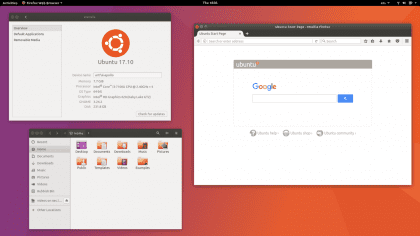
Ubuntu Linux
The first meeting:
I must admit that it was love at first sight, a new world of possibilities, things to learn and without a doubt the new experience of living freely with your team. But like all sudden love, it didn't last long ... I have to admit that at first I had no idea what updating repositories entailed or even how to update a package. Installing my favorite software was always an experience that, although stumbling, left me with a feeling of absolute satisfaction when seeing the window with the program that had taken me (sometimes a little, sometimes a long) time to configure running on the main screen.
Heartbreak:
In a short time I began to notice that in my lack of experience, I had started to install hundreds of repositories, files, programs, etc, etc. So one day I said to myself: "Today we are going to clean the computer" (not that it was slow or anything like that, it just seemed to me that it would be better to have it with a few things that I no longer used). After a couple of hours of cleaning I began to notice that there were many more things than what I had installed in the first place, programs and packages that I was not aware of their function and especially the reason why they were on my system.
Curiosity:
As I finished discovering the news, my ever-active curiosity drove me to keep looking for more things to discover. In this way I started reading about all types of Linux distributions out there. In a short time, names like Fedora, SUSE, CentOs had passed through my eyes ... and the list went on and on until I found one that caught my attention ... Arch Linux ...
Arch Linux is a distribution that blew my mind ... rolling release… Was one of the first things that caught my attention. The second was philosophy KISS. Very soon I began to dream about it, to be able to create my system from the minimum, to know exactly what I had and to have exactly what I wanted, without extra programs, without extra settings. I have to admit that I felt very little capable at the time, in fact I had only been on Linux for a few months, but I thought I could not keep up with the console installation. Fear overcame me and I decided to look for something a little simpler.
My dreams came true when I found Manjaro
Second chapter, Manjaro:
For everyone known to the subject, Manjaro is one of the distributions that focus on bringing the newest users of the Linux world closer to the Rolling Release environment of Arch Linux. Its environment and its applications have a wide selection of programs that make life easier for any user and allow them to become familiar with pac-man, Arch's package manager.
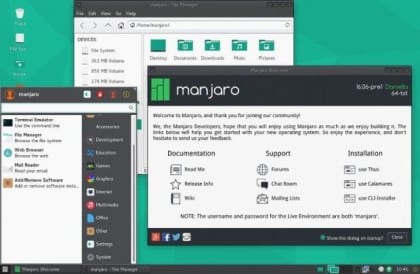
Manjaro Linux
I had been using Ubuntu for just over four months, and I decided to go with Manjaro. I said to myself, "If you can handle this, you'll be closer to being able to install Arch on the laptop." It was an enriching experience, I was able to learn how different types of kernel were handled (and find out what the kernel was) here. I was able to install a lot of new packages and learned a lot about configurations and the bare minimum that a system needs to boot. At the same time, I began to practice the Arch installation process on virtual machines. Without feeling fully prepared to make the leap, I decided to try installing Arch on a machine that I could borrow at high school. Following the installation guide and the occasional online tutorial to the letter. And in the blink of an eye, I had it done, the complete installation on my laptop.
Third chapter, Arch:
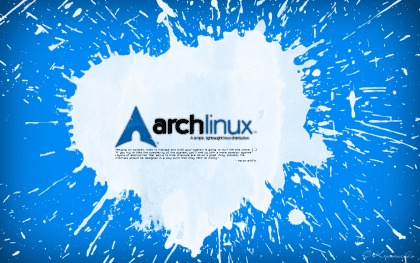
Arch Linux
My first installation had a lot of setbacks, I was still unaware of many things about the world of Linux, but at least I already felt a little more experienced in the subject. He had managed to install a system that others considered difficult and I had succeeded on my second attempt (the first was on the machine I borrowed from high school). Soon after I decided to reinstall my system, it seemed to me that there were still many things that I could configure better, or install better. Over time I realized how few packages I really needed to run my laptop, and I became more and more comfortable with the terminal, commands, and file locations.
Everything was going great until one day, while surfing the internet, I came across an image that aroused my curiosity ...
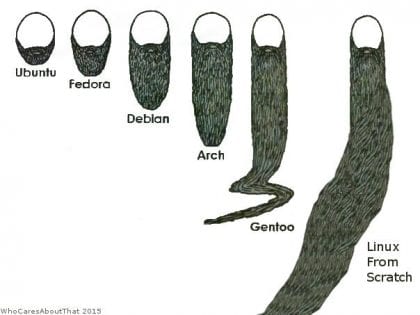
What was this? Was there anything more advanced than Arch Linux? Gentoo? Linux From Scratch? ... My curiosity was calling again. More determined than ever to start this new challenge.
A new chapter, Gentoo:

Gentoo Linux
The first thing you come across when talking about Gentoo is documentation, a lot of documentation. The Gentoo Wiki It is a wonderful place where you can find all kinds of information regarding thousands of programs and settings. But the most basic of all was a compendium full of architectures and processes called Gentoo Handbook.
In the Handbook one can find step by step everything necessary to be able to install Gentoo from scratch. Highly detailed and explained in an understandable way, this manual takes you through the Gentoo Linux setup and installation process. I must admit that I tried to postpone the installation as long as I could, thinking that I was not going to be able to complete it, but one weekend, with all the excitement and a little fear, I launched into the installation that would change the way I see Linux.
The process took me just under two days (one day of pre-reading and one day between compilation and installation). I say compilation because in Gentoo you can compile all your programs instead of downloading a binary copy, but it's actually pretty much like pacman, apt or even yum. One of the longest processes was the kernel, the configuration part, reading the options, selecting what was necessary. Another new world of possibilities and forms of customization that escaped all the other distributions that I had seen until that moment.
With the process done, I can't deny that it was a totally new thrill to see my GNOME desktop environment turn on for the first time, move my mouse, and see everything I had accomplished with my work. All this happened in January and since then I cannot deny that every day I learn more about this shocking distribution, and I have decided to stay here until the day I stop using a computer.
The true beginning:
This is the third time I have installed my laptop with Gentoo from scratch, with each installation I feel more the ability to better configure my computer, get the most out of my hardware and enjoy the excitement of knowing that the equipment is completely mine, and that I'm the one who makes it work.
I have also tried installing Linux From Scratch (it was definitely a must for me). I was able to complete it and turn on my terminal, knowing that I had compiled each program from scratch, and had assembled it from scratch inside my laptop, another wonderful experience I must admit.
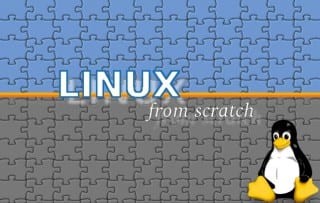
linux from scratch
But it is at this point that I have found and reinforced the reasons to stay on Gentoo and continue to enjoy my distribution.
A quick look at Gentoo:
At the end of this adventure I have chosen Gentoo for the following reasons:
Having a community makes maintenance easier:
This will always be true, Linux from scratch is wonderful, but it is not possible to maintain it in a simple way, much less when there are security vulnerabilities involved, or when you want to have the latest software on your computer.
A world-class community and documentation:
The Gentoo documentation is great, everything is available somewhere, just a matter of reading. In case you can't find it, you can always find someone on IRC for advice. Many are very friendly, and although not very talkative, most are always in a position to help everyone.
Total control and performance:
When using Gentoo, you build everything, and everything is EVERYTHING. But the main difference with Linux from scratch is that after installing it, maintenance is quite simple. Portage, Gentoo's package manager, is extremely versatile and allows you to configure in every detail (and in a simple way) the attributes of the programs you install. This configuration at the same time allows you to squeeze the most out of your computer's hardware. If your laptop is modern and doesn't use Gentoo, it is losing a lot of its potential.
To end:
If you've made it this far, I hope you've been able to get a little excited about the wonderful opportunities Linux offers its users. The power of knowing your machine in every aspect, if you are a software developer like me, is one of the most satisfying experiences you can experience. If your curiosity inclines you to try new things, I can only recommend DO IT! Without waiting a long time, without putting buts, and if you don't get it the first time, keep trying. In no time, you will realize how much you have learned and discovered in the process.
Very good choice, but I do not understand why you say that it is the third time you have installed Gentoo, if the system can practically go from one disk to another, which in my case was what I did when I completely eliminated Windows and passed all the hdd to ext4 ...
Gentoo is an excellent choice, almost any problem is already solved on the official website and the rest is practically looking for help on the kernel.
Portage's handling of packages is excellent… you avoid many dependency crashes because you decide which versions to use at the last minute.
Hello J. Garcia, it is simple, the first installation I left many options by default, I preferred to play it safe. By the second I already had a bit more control over portage and could put specific USE flags instead of global ones for each program I needed. For the third time I have started working with my kernel, releasing drivers that my computer will never use, and improving performance as much as possible.
I preferred to start from scratch because with the passage of time the configurations began to go out of the general line, and I preferred to learn how to configure everything right from the beginning.
Thank you very much for your comment
I've been using Debian for 4 years (and I've used Puppy for a while), and it's the Linux I've used since I discovered Linux. Gentoo sounds interesting, but it may take a lot more experience to one day install it properly. xD
hahaha with a little time and if the article is well received I promise to make small guides of the most common when installing 😉 with a little practice it all comes down to about 15 lines of code more or less.
Regards,
Hello, I have read this article, and this question always arises when installing a linux distribution, one day I asked a colleague, who recommended me, and he told me to install slackware, a very robust linux distribution, with very low chances of packages being corrupted, that's what he told me and hinted that any distribution that uses precompiled operating systems. sooner or later they fall. The truth is that I listened to him, and it was not easy for me to handle this operating system, I had to compile absolutely everything, but it was true it never gave me any type of error and the packages always worked, the system never shut down. to this day it still works. Regarding gentoo, I've never used it, does it look like slackware?
Gentoo has roots in FreeBSD, at least its package management system, portage. Like Linux from scratch, Slackware is a hard-to-maintain distribution. If you only have to run a web server like Apache, or perhaps a Proxy, they would be a good option to consider, because having fewer programs, the attack vectors are greatly reduced.
But for personal computers this is not so simple, everyone wants to have their programs updated and especially that the update process is not very tedious. Gentoo having a Rolling Release system, allows to have all the software updated by means of a simple «emerge -avUD @world». Portage will resolve all dependencies and only under very rare situations will any other manual work be required.
Another advantage is the security support that we offer, (like many other communities) where you can check if your system has any package with known vulnerabilities through "glsa-check" ...
I don't know how the Slackware community works, but the Gentoo community is quite active in terms of development, always improving tools and processes, definitely a distribution to consider.
Regards,
In fact, Portage does look like the FreeBSD ports, but otherwise Slackware is the closest thing to a BSD that can be found in Linux distributions, except of course those of the Debian / BSD, Gentoo / BSD, etc. type. And Slackware at first is a bit difficult to maintain but once you learn how it works it is quite simple.
Thank you for sharing that journey; it has been motivating.
It would not hurt if on another occasion you would also show it in a practical way, showing the steps to follow, the meeting places or with an installation video.
One question: is it required to know English?
The installation manual is translated into more than 6 languages 😀
Here the link:
https://wiki.gentoo.org/wiki/Handbook:Main_Page/es
As soon as I have a little time, I am going to start writing a small practical guide, as this is my first post, I preferred to tell a little about my experience and see if I had people interested, even if it is only for one I am more than willing to start to write the basic installation tutorial, although it will not be very different from what you find once in the manual 🙂
Soon I will be uploading a little more about it.
Regards,
excellent that SO makes me curious
I think that a few months ago I was like you and I ventured to install distros from scratch, however the time increasingly shorter, the occupations that make you want to take advantage of more family time, my daughter have made me forget that way of living, In my years knowing a little about the world of Gnu / Linux I got to Archlinux understanding in depth what it was about, I learned about Rolling Release, KISS and I was left with the desire to migrate to Gentoo, I hope with a little more time to achieve it I have a ASUS 0th generation that the last time I decided to put Debian had problems with the Video card and the wireless network, the last thing was not difficult but the Video card was an inconvenience to connect to another screen and / or projector, SmarTV, however I would like to try it, I am a Python developer, children's teacher, entrepreneur and a proud father of a family. I hope to give myself a few days to venture with Gentoo.
I think what you say Statick is great es it's always good to have clear priorities.
From what I can see your machine would be great for Gentoo 🙂 powerful processors love the versatility of portage, my i7 flies with Gentoo, and whenever I install I see all CPUs at 100%, that is something I have never seen in any other distro . (100% is because I tell it to use all its hidden power when compiling the programs, but I can usually use other things like Virtualbox or Chrome while updating)
As for Python, Portage is probably for you too 😛 as it is entirely written in Python, and many of the community-developed programs are also in python.
It will surely be a fun experience when you can jump to Gentoo 😉 and if I can help you do not hesitate to ask 🙂
Regards,
For me Gentoo Linux is the cornerstone of distros. After 2 attempts which ended in failure I was able to install it on my laptop (a 5rd generation core i3). Despite the warning of complications due to incompatibility with systemd and Gnome I managed it. But I think the warnings were not in vain, as the performance was lower than what I was used to in Arch Linux.
I currently use Arch Linux with Gnome, I don't lose hope of using Gentoo Linux with Gnome. I have to understand some details related to masked packages and maybe details that I am not even considering.
I will try to install Gentoo when I have a more powerful PC because I think that is precisely one of the virtues of this distro; get the most out of your hardware, and the more modern the better
since the compilation of the packages is faster.
I would like you to do a tutorial on how to install Gentoo with Gnome, I would greatly appreciate it.
I liked this story and it encourages me to install Gentoo. See you soon…
Well, I currently have my Gentoo with systemd and GNOME 🙂 it took a bit of configuration, but with a little reading it was quite simple 😉 I will start with that article soon
the good and the new is to be enjoyed congratulations for your contribution thanks
The good one to share it 🙂 and in this case, the idea is to share GNU / Linux and all its benefits 🙂 greetings and it is a pleasure to share a little of my adventures in Linux
Christopher, how good the stories of your trip, I think that many of us have gone through a similar log in one way or another. I am not a Gentoo user, and in particular I have only used the distro a couple of times on the computers of a fellow member of the community, but without a doubt your article and your experience inspire me to prioritize the startup of a computer with Gentoo installed.
Thank you very much for the contribution you are giving to the community of desdelinux, and I hope to read you very often here, as well as those users who wish to share their experiences and knowledge.
Thank you very much, lizard 🙂 it is a pleasure to be able to share a bit of my experience with others and thus encourage them to try a distribution that I love 🙂 as well as build a small Spanish-speaking group in Gentoo, because there are people from many parts of the world, but few Latinos and Hispanics 🙂 Greetings, and soon I will have another article to share 🙂
I always wanted to install Gentoo but for something or another I could never do it but after reading your blog I think it is time for me to switch to Gentoo / Funtoo, save that first to practice in a VM haha.
You saw Funtoo I don't know whether to go to that or throw it to Gentoo
Of course I saw Funtoo 😉 after all, the creator of Gentoo founded Funtoo too 🙂 to be honest I have never installed it, I have a tendency to go towards the root and the same as Manjaro and Arch, I preferred Arch for being the root, but I have heard very good references from Funtoo too 🙂 Regards
In no time, the yoyo friend will make a post passing to the crowd because it's cool
haha I don't understand very well, I suppose it will be because of the proofreader, or maybe because I am from Spain (here in Peru we don't use "cool") but it would be great to have more people in the Gentoo community 🙂 especially if they speak Spanish.
The article seemed great to me, I like the LINUX world, because I feel free, it is a philosophy of "Do it yourself", "Do it as you please", "Do it in community", that freedom to do things at our way is very nice. Something that I also like is that there are distros that go from the simplest to the most complex, for all kinds of tastes
Thank you very much 🙂 you're right, the beauty of all this is that everyone finds what they like the most and feel really free when using it. Greetings 🙂
Got damn! You made me feel miserable hahaha
I've been escaping from Gentoo for over a year, I'm a Bunsen Labs user, I've been through dozens of distros, I've already finished two hard drives from installing so much. The truth is that your article moved me too much and made me wake up that flame to try again, the last time I did it I stayed in the network configuration, since I have always had problems with my network card: /
I plan to give it again this weekend 😀
Really thank you for posting this, it was too inspiring, it came at a great time!
regards
Thank you very much for your words 🙂 and if your card gives so much trouble, try to install it from your own system, everything has already been configured 😉 that will help a lot 🙂 Greetings
I didn't really think about it at the beginning, but in the end it was a very good and interesting article. I also like Gentoo, but the truth is that I haven't touched it for several years. I had it installed for a while until I met Arch at a time when this distro was directed by Judd Vinet, it had the A logo in light blue and half curved "Judd Vinet started Arch Linux in March 2002", I remember those times and I was able to be part of your progress to the Arch today. Maybe one day I'll have Gentoo again and I think your article has motivated me to make it soon. The truth is that one thing that bothered me about Gentoo was that their packages were not pre-compiled like Arch's and just doing a kernel update could take you a long time to do it, hours and hours when it only looked like it was. I compiled the kernel and other update packages, taking into account that at that time we did not have the broadband connections that we have today and the entire internet was super slow. I am not a software developer, but sometimes I have had to be a web developer, I also really like computer security, operating systems and virtualization issues. Since I met the Linux world I have chosen to only use and learn about free software and OpenSource alternatives. Thank you very much for your contribution and I would like to keep in touch. Greetings from Bogotá Colombia.
Hi Nelson 🙂 it's true, today it is much more feasible to use Gentoo, especially on more modern equipment, the possibility of squeezing the most out of the hardware is quite tempting 🙂 and of course, participating in FOSS projects is something that I enjoy a lot, and Surely I can infect more than one to collaborate in these, even if they are small things 😉 It is always a pleasure to share and surely they will be seeing me here or well, where the internet joins us 🙂 Greetings
What envy! 😉
Although I have known him for years, I have been using GNU / Linux exclusively for a little over a year (Debian, only with the main repos) and I have loved the journey you tell me because of how much it has reminded me of the path that I have set for myself, like this that I will follow this series with great interest and how do I have a laptop to install, why not Gentoo?
I am very curious to see the origin and environment of that image of the distributions, would you have the link at hand?
Thank you very much
Clear! Gentoo may be your next option 😉 unfortunately I can't find an original source for the image, it seems to be one of those internet mysteries that has spread so fast that there is no single starting point ... But if I ever find it, I know where to put the URL 😉 Greetings
Congratulations Chris, excellent your comments, I have been using linux for 3 years and I am not leaving it for nothing, I have Archlinux, deepin and KaOS, ahce about a year I tried to install Gentoo, following this guide https://rootsudo.wordpress.com/2014/09/14/manual-casi-facil-para-instalar-gentoo-paso-a-paso/ unfortunately I got lost and left it alone, hopefully you can upload a tutorial to install Gentoo, Greetings and forward
The tutorial is coming out soon 🙂 of course it is always useful to have the Handbook at hand to be able to consult any problem that may arise in the process 🙂 I recommend doing it from a distro that is already fully configured, so many of the initial configurations are easier. I install Gentoo from my Arch partition whenever I need to 🙂 Greetings and good luck with the future installation
The article is interesting, I do not know what is more difficult if installing Gentoo or installing FreeBSD, with that systemd that is taking over the entire system, in linux / gnu there are few systems without systemd, and one of them is gentoo, I almost don't like it nothing compiling.
Well, I have never exited the CLI in FreeBSD so I have not experienced its desktop environments, but to tell the truth the process seems easier to me ... at least there is an installer that tells you what to do at each step in FreeBSD 🙂 Well, I know It's about choice in Gentoo, you can choose between everything, and that includes init systems 🙂
regards
Gentoo has been catching my attention for a long time. I've been a linux user for more than 15 years, and right now I'm on arch. Greetings and congratulations on this journey, a wonderful journey to curiosity and knowledge.
Brother, grateful to you immensely. His articles inspire for the good and the best.